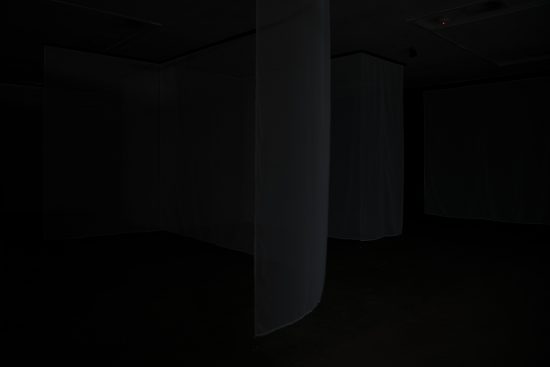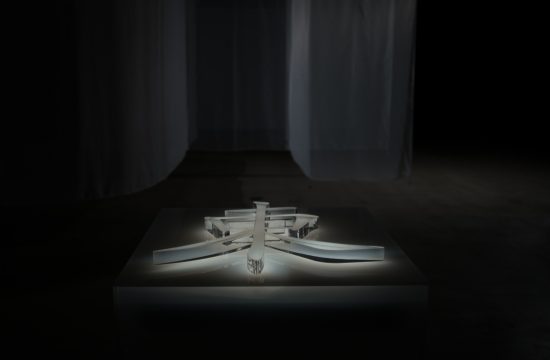Guest blogger Nadia Odlum, reporting from the darkness…
The gallery is dark. I breathe the cool air slowly, and wait for my eyes to adjust. The entrance passageway contains a small explanatory text, softly lit. I read: ‘In-audibility, In-visibility’, an exhibition presenting the culmination of research by Master of Fine Arts candidate Bronwen Williams.
Turning left the darkness deepens, but I see a soft glow ahead that draws me forwards into the space. There is something set on an illuminated pedestal. I feel as though I have entered a cave, and a secret of artefact is glowing and beckoning from its centre.
But I can’t walk straight towards it: through soft variances in the light I perceive that the room is divided with walls of sheer, white silk, hung at irregular placements and intervals, creating a labyrinthine organisation of spaces and passages. These barriers check me, pause and redirect me, and as I shift my navigation the full sensory experience of the installation emerges…
Thrumming throughout the space are various beat frequencies, projected by numerous speakers embedded in the ceiling. The complex reverberations present an array of amplitudes, which swell, fade and pulse. Each beat seems to reach out to me from afar, envelop me as I walk beneath its source, and then gently release me as I continue on my way. When in between the sources of the sounds I experience a superposition of auditory influences, which vie for dominance and disrupt my sense of location in the darkened space.
Interspersed with the beats, I also come to identify the sound of quiet voices. I move closer to one of the sources – a female voice recites a list:
Scrambled eggs,
Dandelions,
Saffron rice,
Corn kernels…
And onwards, on repeat, a litany of yellow foods.
Other female voices seem to deliver extracts of texts or interviews. Straining to hear them, I become more acutely aware of the throbbing rhythms that continue to course through the dark.
This immersive installation is the product of William’s research into the possibility of sound, as a material, to speak to a contemporary understanding of hybridity. Specifically, the artist explores her own experience of cultural hybridity as an Asian-Australian woman. The result is an exhibition that harnesses psychoacoustic phenomena to draw the audience into an embodied experience of multiplicity, and the temporal overlaying of many spheres of stimulus and influence.
Many Australians, like Williams, experience a sense of identity derived from the influence of more than one cultural origin. While this can be enriching, it can also lead those experiencing it to feel discordant, or out of synch with those around them. Williams says of her experience “There is a perpetual tension that occurs when my multiple points of cultural input converge as each marker of identification shifts between central and peripheral dominance. This creates oscillations and vibrations that underpin [my] everyday experience…”* In this hybridity, identity adopts an unfixed and fluid state, unbound or restricted by rigid categories, existing dynamically in the in-between.
Exploring the installation, I am struck by how William’s work encourages me to consider the ways sound can express this state of ‘in-between’. I am also drawn into a heightened awareness of the act of hearing itself, not as a simply mechanical or biological process, but as a temporal and perceptual event. The subtle structural element of the silk screens encourages a meandering exploration of the space, which would result in an entirely different sequence of auditory stimulation for each visitor. The careful placement and combination of sounds draws my perceptual attention variously left, right, in front or behind, creating a complex experience of spatial destabilisation.
In addition, the de-emphasis of vision (so often the privileged sense) that is achieved by the darkened space results in a heightening of the other proprioceptive senses. I walk slowly, weighing my steps and balance. In the dark, the silk hangings touch softly against my arms as I move past. When I reach the outer wall, I press my cheek against it, and feel the ‘womp, womp, womp’ of the beats run through my skull.
When I finally approach the illuminated pedestal in the centre of the room, the point of light that had drawn me so inexorably into the space, I see that it is topped with a Chinese character, beautifully cut from thick, clear acrylic. I later learn that it is the Chinese character for ‘East’ and that the silken hangings are not, as I had first imagined, hung at random, but actually form an enlarged version of the Chinese character for ‘West’, if seen from the top down. In using these two symbols Williams engages with Edward Said’s ‘Orientalism’, which highlights the false dichotomy represented in these two terms, which were created by the self-proclaimed west to split the world in two. These terms are based in language, yet in William’s installation they intermingle to co-define space, through the transparent barriers and the permeating presence of light.
I exit the space with a lingering echo in my ears, and a heightened sense of the potential of sound, and carefully executed installation environments, to communicate and grapple with complex societal issues. ‘In-audibility, in-visibility’ is in its final week, and I encourage you to visit UNSW Galleries and immerse yourself in this multisensory environment, and engage in a process of active listening to the spaces, and experiences, in-between the beats.
‘In-audibility, In-visibility’ continues at UNSW Galleries until 14 April 2018. *From the artist’s website, www.bronwenwilliamsart.com






